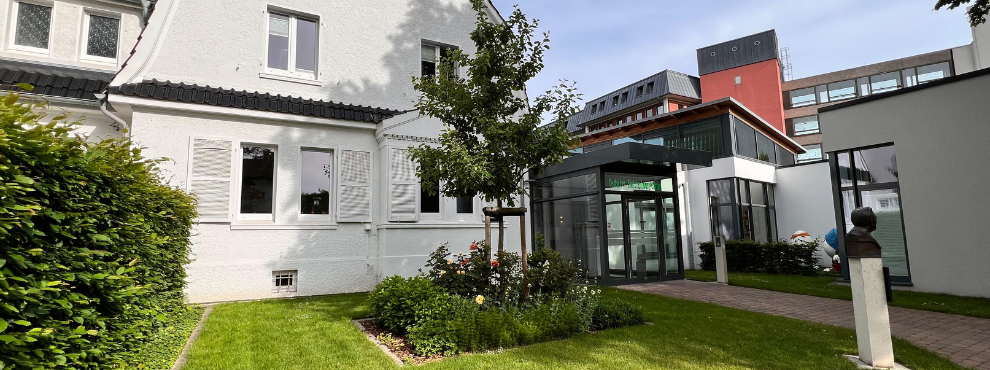Superheroes against pain
20 years of the German Paediatric Pain Centre - 20 years of help for chronically ill children

What do Spiderman, Catwoman, Captain America, Wonder Woman and Supergirl have to do with chronic pain in children and adolescents? Do they perhaps also have headaches, abdominal pain or muscle and joint pain like the young patients, or why can the superheroes be found everywhere in the Vestische Kinder- und Jugendklinik Datteln - Witten/Herdecke University?
"Our goal is to help children and adolescents with chronic pain to get their pain under control again," explains Prof. Dr Boris Zernikow, founder of the German Paediatric Pain Centre. "Children and adolescents suffering from pain have the strength, courage and skills to do this, just like a superhero. We just help them to find these sources of strength and utilise them so that they can lead a self-determined, happy life again."
Focusing on strengths and abilities
For twenty years, a multi-professional team of psychologists, doctors, nurses, social workers, teachers, physiotherapists and other therapists in Datteln has been working to help children and young people learn to overcome their chronic pain. Their approach is to focus on the strengths and abilities of the affected families, take children seriously, see families as experts, treat each other with respect and work at the very highest level. These are values to which the team has committed itself in its work - and its success proves it right: young patients from all over Germany travel to the German Paediatric Pain Centre in Datteln to receive help here.
And: it works! Internationally published academic studies show: "More than 60 per cent of children can be permanently cured and 20 per cent experience a significant improvement," explains Dr Julia Wager, Head of the Research Department at the German Paediatric Pain Centre. "And we are working hard to ensure that we can also help the remaining 20 per cent of our patients," adds child and adolescent psychotherapist Dr Michael Dobe, who has been involved for 20 years and helped establish the German Paediatric Pain Centre. Dobe and Zernikow have described their approach in detail in a specialist book published in German and English by the renowned Springer Verlag. "This means that every paediatric clinic in the world can simply copy what we have tried and tested," says Zernikow happily, "and there are now many clinics around the world that work successfully according to the Datteln model."
"For many children, we are preventing even more pointless operations."
Over the past 20 years, more than 10,000 children and young people with chronic headaches, abdominal pain or muscle and joint pain have been treated either as outpatients or inpatients on one of the two paediatric pain wards. "We stand by the children so that their pain is believed and they are saved from the usual 'don't be like that, you just have to want to...'," says Alex Tüllmann, head of the paediatric pain ward. "For many children, we prevent even more pointless operations and the constant digging for the ONE cause," adds nursing manager Annika Rips, head of nursing.
There is no one single cause of chronic pain, explains Prof Zernikow. "Chronic pain arises from an interplay of psychological, social and biological factors. Ultimately, the child's brain learns pain like a foreign language. So nothing is broken in the body, on the contrary, the pain-reinforcing nervous system works well, even particularly well. Our common goal is for pain to be unlearned and pain processing to normalise."
Solving current problems, learning coping techniques, trying out normal everyday school life and plenty of exercise despite pain are important elements of therapy. The physiotherapy department is to be quickly remodelled so that exercise can take place in groups and with a lot of fun, even with increasing corona incidences in winter. "We still need a few euros for our 'RaumGeben' project," says Zernikow. "It would be a great birthday present if we received support here so that we can help the kids even better!"
Background:
20 years ago, in 2002, Prof. Dr Boris Zernikow opened Germany's first paediatric pain outpatient clinic at the Vestische Kinder- und Jugendklinik Datteln - Witten/Herdecke University. In 2011, Federal President Christian Wulff awarded the paediatric pain outpatient clinic and ward the "Selected Landmark" prize in the "Germany Land of Ideas" competition. Together with the Children's Commission of the German Bundestag, the German Paediatric Pain Centre was then ceremoniously launched.
The advisory board of the German Paediatric Pain Centre includes Dr Jens Baas, Chairman of the Board of Techniker Krankenkasse, Dr Dirk Spelmeyer, Chairman of the Board of Kassenärztliche Vereinigung Westfalen Lippe and Prof. Dr Martin Butzlaff, President of Witten/Herdecke University. Former Federal Minister of Health Ulla Schmidt and Dr Theodor Windhorst, former President of the Westphalia-Lippe Medical Association, also actively supported the German Paediatric Pain Centre in Datteln during their respective terms of office. The German Paediatric Pain Centre is now the world's largest facility for the treatment of children and adolescents with chronic pain. Every year, 1,500 patients are treated as outpatients and more than 300 as inpatients. Cooperation partners with similar treatment offers are the Bavarian Paediatric Pain Centre at the University Children's Hospital Augsburg and the Baden-Württemberg Paediatric Pain Centre at the Olgaspital in Stuttgart, as well as internationally the Children's Hospital of Harvard Medical School in Boston, USA.
Further information can be found at https://www.Deutsches-Kinderschmerzzentrum.de
You can access the anniversary brochure to mark our 20th anniversary at https://www.deutsches-kinderschmerzzentrum.de/fileadmin/media/PDF-Dateien/DKSZ_Jubilaeumsbroschuere_web_07_2022.pdf
Photos for download
Contact person

Svenja Malessa
Press Officer
Administration | Communication & Marketing
Alfred-Herrhausen-Straße 48
58455 Witten
Room number: 2.F05


